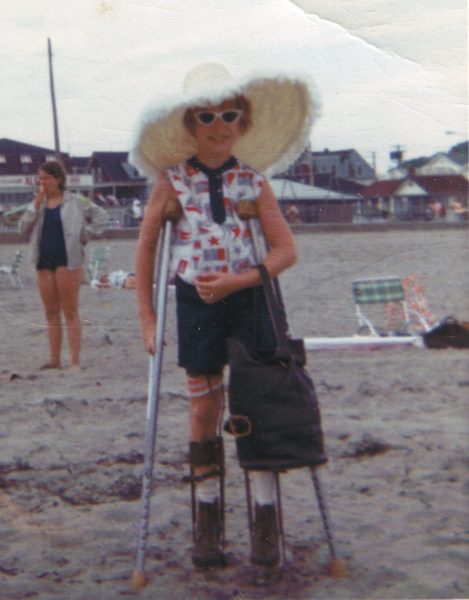
Vicki Jacobs-Pratt got in touch with me recently to ask if I’d write something about Bleeding Disorders Awareness Month, which is in March. When she told me she had von Willebrand disease, I said “huh?”
When I think of bleeding disorders, the first one that comes to mind is hemophilia. It may be the most widely known, but I found out that it’s not the most common.
After Vicki and Dr. Helen Ryan, a hematologist at New England Cancer Specialists, brought me up to speed on von Willebrand, I knew it was important to pass along the information.
What is a bleeding disorder?
A bleeding disorder is actually a group of disorders that develop because the blood doesn’t clot properly. When we get injured and bleed, our bodies form a clot to stop the bleeding. For that to happen, you need platelets and clotting factors (there are 13!) in your blood. Depending on what kind of bleeding disorder you have, your body may not have enough of a factor or it doesn’t work the way it should.
There are several bleeding disorders. Among them, hemophilia, the one nearly everybody knows about and von Willebrand disease — much more common, but less widely known.
Hemophilia
Hemophilia may be the most well-known bleeding disorder but it’s actually rare. It’s found in 1 of 5,000 live births.
It’s caused by a mutated gene that can be carried by both males and females. If a male is born with the gene, he will have hemophilia. If a female is born with it, she won’t have hemophilia, but she can pass the gene on to her children — if it’s to a son, he will have hemophilia and if to a daughter, she can pass it on to her children. Although it’s extremely rare, hemophilia can happen in a female.
“Hemophilia occurs when you are deficient in a coagulation
von Willebrand disease
Even though I had never heard of it before, von Willebrand is the most common bleeding disorder. It’s also caused by a genetic mutation that is passed down from parent to child, but unlike hemophilia, the mutation is not on a sex chromosome. That means von Willebrand disease can affect both males and females equally.
Someone with von Willebrand is missing another important clotting factor in the blood. It’s known as the von Willebrand factor, after the doctor who first brought it to light in the 1920s. The bleeding it causes usually happens in the form of bruising, nosebleeds and heavy periods. Most cases are mild, but Vicki, who will be 58 in May, was born with the most severe form.
” I was diagnosed in 1960 when I was 18 months old,” she said. “My mother noticed bruising on my back when I was six weeks old. It took 18 months to get a definitive diagnosis. They ran some tests and did a lumbar punch to see if I had leukemia. I guess I bled excessively from that, but they didn’t know what was wrong with me. They sent me to Boston Children’s Hospital and a hematologist there had just come back from Europe. He’d been studying von Willebrand disease and said that’s what I had.”
- If you have type 1, which is more common (in 60% to 80% of patients), it means you don’t have enough von Willebrand factor in your blood.
- If you have enough, but it doesn’t work as it should, it’s called type 2.
- Vicki has type 3 (in 5% to 10% of patients). She has no von Willebrand factor in her blood.
Some people can develop von Willebrand disease after being diagnosed with an autoimmune disorder, heart disease or some types of cancer. Some medications can also cause the disorder. Most of the time, people are born with the disorder.
von Willebrand symptoms
Because Vicki has the severest form of von Willebrand, she’s had a lifetime of medical issues. Once she started crawling and walking, she also started having spontaneous bleeding into her joints.
“By the time I was five,” she told me, “my ankle joints were totally gone. They had degenerated. The doctors didn’t expect that I would be able to walk or do anything. I was taken off my feet when I was six and put into leg braces six years.”
Thankfully, she was able to walk when the braces came off, but all through school there was always something. “Almost always,” she said. “One of the symptoms of von Willebrand is nosebleeds. I had, at least, one a week. In some instances, I had to have blood transfusions because my nose bled so much.”
Most von Willebrand symptoms are not as severe as Vicki’s and many times, they get missed. Dr. Ryan emphasized that any unusual bleeding or bruising should be checked out. “By unusual bruising, I mean easy bruising,” she said. “Bruises that appear for no reason, are not associated with trauma or are in unusual locations.”
Sometimes, people won’t realize anything is wrong until they have a major injury, surgery or deliver a baby and bleed more than usual. Looking back, they’ll remember all the nosebleeds they’ve had since childhood or their heavy periods.
Here are some possible symptoms you should consider:
- Do you get frequent nosebleeds or ones that go on for more than 10 minutes and sometimes land you in the emergency room?
- Do you bruise easily or for no apparent reason?
- If you’re a woman, do you have heavy and/or long-lasting periods?
- Do your gums bleed for no good reason?
- When you have your teeth cleaned or undergo a minor medical procedure do you bleed more and longer than expected?
- Do you bleed after taking aspirin or another medication that inhibits clotting?
If you’re concerned, you should be evaluated by a specialist who understands bleeding disorders.
Treating von Willebrand
Today, Vicki infuses herself three times a week with a clotting factor to help prevent bleeding episodes. “When I first started,” she explained, I was treating on demand. When I had a joint bleed or a nose bleed or knew that I was going to be having a procedure done at the dentist. But now, I’m reaching arthritis age and we’re trying to keep my bleeding disorder in check so that I might be able to grow old gracefully.”
People with the mildest form are treated when necessary with a medication that releases von Willebrand factor from their own cells. “It increase a person’s own von Willebrand factor,” said Dr. Ryan. “Someone with a mild case probably has the factor, just not enough. The medication increases the amount in the blood. It can get you through, say, a period or a medical or dental procedure. It’s not regularly scheduled.”
An interesting thing about von Willebrand factor is that levels go up during pregnancy. “So oftentimes, we don’t need to treat during pregnancy or at the time of delivery,” said Dr. Ryan. “However, patients with a severe type do need treatment.”
Hormone replacement therapy and birth control pills can also increase levels. What concerns Vicki is if an undiagnosed woman has been on birth control pills, comes off and gets pregnant. If she has von Willebrand disorder, she could be at risk for postpartum hemorrhage.
The important takeaway messages from this post are:
- If you have any of the symptoms you should have them checked out. Diagnosis begins with some blood tests.
- If you have a bleeding disorder, the most common one is von Willebrand disease. In most cases, its symptoms are mild and easily treated.
You’ll find a lot more information about von Willebrand and other bleeding disorders on the following websites:
National Hemophilia Foundation
Many thanks to Vicki for contacting me and for sharing her story. Vicki is also Executive Director of the Hemophilia Alliance in Maine. The organization is for people with all types of bleeding disorders. And thanks to Dr. Helen Ryan for her expertise.
If you have a health and wellness topic you’d like me to consider covering on the Catching Health blog, send me an email or tell me about it in the comment box below. ~Diane


Leave A Comment